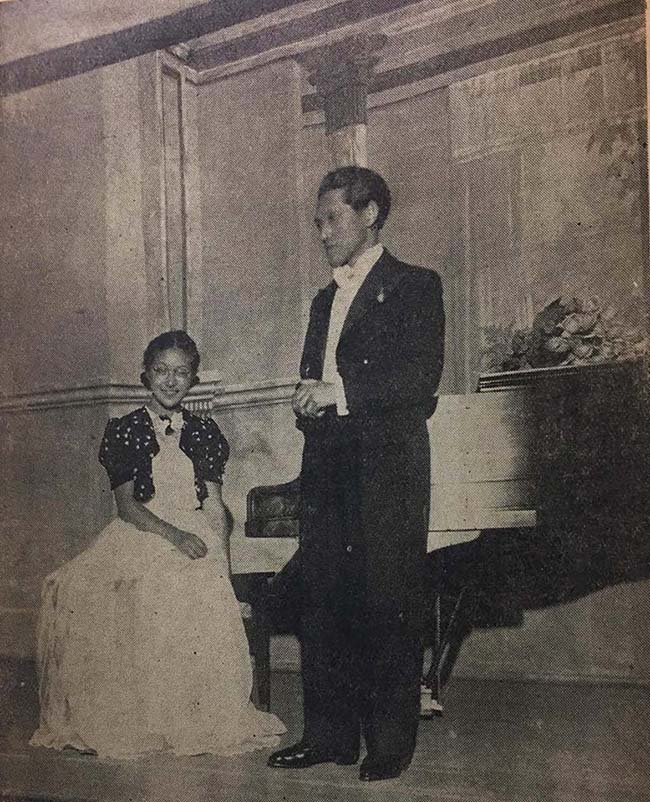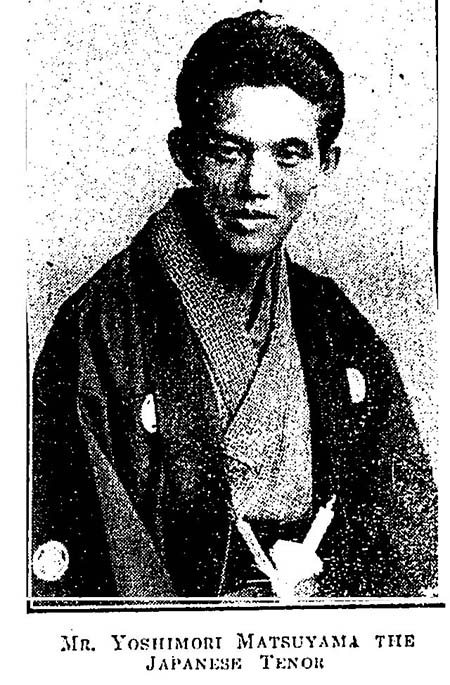Yoshinori Matsuyama
Born in Kagoshima at some point between 1889 and 1896 (most probably in 1891), Matsuyama was the son of a violinist, and first studied the violin also himself, at the Tokyo Music School. When he decided to switch to studying voice, his teachers didn't accept, and he left the school, and soon also Japan. In the US, he settled in Berkeley and, as the story goes, worked as a houseboy for a music-loving family that recommended him, before long, to a concert promoter. Whether true or not, he did in any case embark on a singing career – also in concert, but primarily in vaudeville, where he gained a certain popularity as the "Japanese Caruso". He appeared, for instance, in Seattle, Vancouver, San Diego, Portland, Salt Lake City or Cheyenne. He sang mixed and varying programs of Western and Japanese classical songs and operatic arias (partly in Japanese translation!). Then, sponsored by a Japanese-American scientist, he moved to New York City and studied voice, first with Evelina Hartz, then with well-known singing teacher Percy Rector Stephens, while also continuing to appear in both vaudeville and concert, for instance in a dance performance by the famous modern Japanese dancer Michio Ito – accompanied by vocal music, sung by Matsuyama (April 1918, Greenwich Village Theater). However, for unknown reasons, he migrated again in November 1918, and went to England, where he continued to perform the same way as in America. Financially, it was a very difficult period for him, and in 1920, he moved to Italy and studied opera in Milano and Naples. In early 1922, he settled in Paris, where he made a serious career – not as much as a singer than as a composer! For his songs, he wrote not only the music but also the texts, he translated them into French, and he even drew the Japanese artwork for the printed edition of the scores. But he performed also European lieder, in Paris as well as in Lyon, and once again, he joined forces with Japanese dancers; their programs ran at the Théâtre des Nouveautés, and even at the Théâtre des Champs-Élysées. He became quite popular with Paris audiences, and some of his songs even became part of the repertory of African-American pioneer tenor Roland Hayes. In 1925, Matsuyama returned to Japan, announcing that he would form a company of singers, dancers, instrumentalists and mimes, and present a new program of Japanese music in Paris the following year. That company never materialized, and Matsuyama stayed in Asia. Not for long in Japan, though: in January 1927, he opened a vaudeville café in the international quarter of Shanghai. As a singer, he regularly performed both at his own café and elsewhere in Shanghai, mixed programs of his own and of Western songs and operatic selections. In 1928, he went back to Japan, and opened a singing school in Tokyo, however still giving occasional recitals himself. In March 1933, he finally sang opera on stage: Duca di Mantova at the Asahi Kaikan hall in Osaka, in a production organized by the "Asahi Shimbun" newspaper. Most of his time was now devoted to teaching, though. In April 1938, he set out on a tour to the US West Coast, after an absence of almost 20 years. He had great plans of staging opera and operetta with Japanese-American singers and musicians; the Japanese-American press sponsored his tour. He stayed for almost a full year, and gave numerous concerts in Seattle, Vancouver, San Francisco, Los Angeles, Sacramento, San Diego, and finally in New York City. The whole tour remained within the Japanese-American community, the general American public hardly took any notice of it; and it was ultimately no success: no opera productions, and Matsuyama bitterly complained about the low level of musical education of the Japanese Americans – so bitterly that the community perceived it as utterly offensive. Back in Japan, he was faced with the fact that Western music became highly unpopular during World War II, and he sang only a handful of concerts before his tenor career was over – basically in 1943, although he returned for one concert in 1949 in Tokyo. He continued to teach singing, and also worked as stage director in a few opera productions. |

